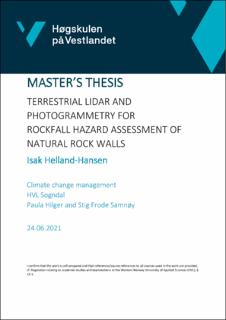| dc.contributor.author | Helland-Hansen, Isak | |
| dc.date.accessioned | 2021-10-22T08:47:15Z | |
| dc.date.available | 2021-10-22T08:47:15Z | |
| dc.date.issued | 2021 | |
| dc.identifier.uri | https://hdl.handle.net/11250/2824926 | |
| dc.description | Master Thesis in Climate Change Management
Department of Environmental Sciences, Faculty of Engineering and Science
2021 | en_US |
| dc.description.abstract | Rock falls have been a major threat to infrastructure in the Norwegian landscape, particularly locations located in the steep valley landscapes in the Norwegian fjords. Roads channeled through these landscapes are particularly exposed. Two rock walls located directly above and along the E16 have historically experienced rockfalls in varying scale. These Sites are potential contributors to future rockfall activity along E16 and have been further investigated in this thesis. Testing the use and application of 3D models made by photogrammetry and LiDAR of natural rock walls was the main objective of this study.
Firstly, 3D models of both photogrammetry and LiDAR was made in November 2020 and April 2021. No rockfall activity could be detected by investigating the 3D models, this was also supported by field observations. By comparing the 3D models of LiDAR and photogrammetry at Site 1, LiDAR was found to be the preferable approach in terms of results where discrepancies between models ranged from cero to two centimeters. Photogrammetry models were had discrepancies ranging from cero to 20 centimeters. Results from site two were far worse considering both approaches and the importance of ground control points well distributed over the rock wall is highlighted as a key point for the performance of the reliability and accuracy of the 3D models. Secondly, a structural geological survey was carried out at Site 1 with the main purpose of getting a better understanding of the rock fall hazard of the rock wall. This survey comprised a scanline survey, block size measurements, a kinematic analysis and field observations. Four main joint sets were identified from the kinematic analysis where set 3F followed the foliation. Wedge sliding was defined as the most likely failure mechanism of the rock wall, including small potential of planar sliding and toppling. A potential unstable area was detected during the structure line that appeared very fractured and loose compared to its surroundings. The measured fractures defining this area did not have critical values for sliding however due to the conditions of the area and history of rockfall at the site it should not be ruled out that blocks in this area have the potential to fall out, especially when considering other mechanisms affecting rockfall. A volume estimation of this potential unstable body was done from Photogrammetry and LiDAR 3D models where the LiDAR model estimated volume 14% larger than the photogrammetry model | en_US |
| dc.language.iso | eng | en_US |
| dc.publisher | Høgskulen på Vestlandet | en_US |
| dc.rights | Navngivelse 4.0 Internasjonal | * |
| dc.rights.uri | http://creativecommons.org/licenses/by/4.0/deed.no | * |
| dc.title | Terrestrial lidar and photogrammetry for rockfall hazard assessment of natural rock walls | en_US |
| dc.type | Master thesis | en_US |
| dc.description.localcode | GE4-304 | en_US |

